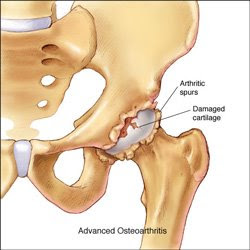Arthritis is the knee's biggest enemy. Caused by injury, disease, or just the passing of time, arthritis causes the pain and joint damage that can lead to hip and knee replacement.
The following offers a summary of information about arthritis.
What is arthritis?
Arthritis is the number one cause of chronic disability. Affecting nearly 1 in 5 people in UK, it refers to more than 100 diseases that cause pain, stiffness and swelling from the inflammation of a joint or the area around joints.
The three basic types of arthritis that may cause hip and knee pain: osteoarthritis and inflammatory arthritis (most commonly rheumatoid arthritis), and traumatic arthritis.
| | Osteoarthritis | Rheumatoid arthritis | Traumatic arthritis |
| Number affected in the UK | about 3 million (most common type of arthritis) | over 400,000 (most common type of inflammatory arthritis) | not known |
| Who is likely to get condition | usually middle-aged and older people | 75 percent are women; most often begins between 30 and 60, but can develop at any age | people who have experienced a hip injury or fracture |
| Definition | joint disease that gets worse over time; does not cause swelling in joints (not inflammatory) | inflammatory condition (causes joint swelling) in which the immune system mistakenly attacks the tissue that lines and cushions the joints | from an injury which leads to a condition called avascular necrosis: blood supply to the ball portion (the femoral head) of the thighbone is cut off |
| Why it causes pain | cartilage that cushions the bones of the hip starts to erode, eventually allows the bones of the joint to grind or rub together | cartilage wears away and the cushioning fluid in the joint (the synovium) becomes inflamed (swollen) inflammation causes chemicals to be released that damage the cartilage and bone of the affected joint | lack of blood supply causes the ball portion (the femoral head) of the thighbone to wither and surrounding cartilage deteriorates and bones grind or rub together |
| Symptoms | pain and stiffness | pain and swelling | pain and other symptoms |


What is osteoarthritis?
Osteoarthritis is the most common type of arthritis affecting about 3 million Britons, usually middle-aged and older people. This is a noninflammatory degenerative joint disease characterised by the breakdown of the joint's cartilage. Cartilage that cushions the bones of the hip starts to erode, eventually allowing the bones to grind or rub together and causing hip pain and stiffness.The exact cause of osteoarthritis is unknown.

What is rheumatoid arthritis?
In some types of arthritis, such as rheumatoid arthritis, the synovium becomes inflamed. This inflammation causes chemicals to be released that thicken the synovium and damage the cartilage and bone of the affected joint. This leads to inflammation of the synovium causing pain and swelling.

What is inflammatory arthritis?
This chronic disease results when, for unknown reasons, the immune system mistakenly attacks the tissue that lines and cushions the joints. As cartilage wears away, the knee often becomes stiff and swollen. A well-known example is rheumatoid arthritis.

What is traumatic arthritis?
The culprit here is a serious hip injury or fracture that can lead to a condition called avascular necrosis. In avascular necrosis, the blood supply to the ball portion (the femoral head) of the thighbone is cut off and the bone begins to wither. As a result, the surrounding cartilage begins to deteriorate, producing pain and other symptoms.

What is fibromyalgia?
Fibromyalgia is the second most common type of arthritis affecting 750,000 people in UK, mostly women; 70 to 90 percent of people who develop this disease are women aged 20 to 50. Fibromyalgia is a disease involving pain in muscles or joints with no clinical signs of infection. It is often misdiagnosed as chronic fatigue syndrome, and usually does not require surgery.
What causes arthritis?
The causes of the 100 types of arthritis are unknown. Because there are so many different forms of arthritis, the causes are likely to vary. Scientists are currently examining how the roles of major factors including genetics and lifestyles affect the development of arthritis.
What changes occur in the cartilage of an arthritic hip?
In a healthy hip, cartilage cushions the area surrounding the hip ball and socket to allow easy movement without pain. In an unhealthy hip, the cartilage is damaged or worn away causing pain from bones rubbing and grinding together.
What changes occur in the cartilage of an arthritic knee?
In a healthy knee, cartilage protects and cushions bone surfaces that come together at the joint allowing bones to move without friction. In an unhealthy knee, cartilage is damaged or worn away causing pain from bones rubbing together.
What are some of the symptoms of arthritis?
The type of pain caused by arthritis depends on the type you have. Pain from arthritis can be continuous or intermittent. Pain may occur after activity or exercise but it may also happen even if you have been resting and still for a period of time. Pain may be concentrated in one spot or you may feel it all over your body. Joints may feel stiff and difficult to move. Daily chores such as climbing stairs and opening cans may become a challenge. You may notice that pain is more severe during certain times of the day or after performing certain tasks.
Some kinds of arthritis cause swelling or inflammation. The skin over the joint may appear swollen and red, and feel hot when touched. Arthritis may also cause fatigue or weariness. Read Easing the Pain to learn more about pain management.
How can I know if I have arthritis?
Early diagnosis and treatment tailored to an individual's needs are crucial in slowing or preventing damage to joints. Only a physician can determine if you have arthritis and what type it is. Arthritis is diagnosed based on the overall pattern of symptoms, medical history, physical exam, x-rays and lab tests.
Your doctor will start by taking your history and doing a complete physical examination. Your doctor may observe you while standing, sitting, lying down, etc. and watch how well you walk around the room. He or she will also examine your hip and knee carefully, looking and feeling for details that offer clues about your condition. He or she will ask you where it hurts and how long you’ve had the pain. He or she will want to know if you fell or suffered any other trauma to the hip.
The location of the pain is often a tip-off of the condition you have. The source is not always what you would think. Pain that truly comes from a hip problem is often located in the thigh or groin area. In other cases, hip pain may be a signal of a problem elsewhere in the body. If the pain is more in the buttocks than the hip, for example, it may actually be the result of a problem in the back. And, while hip pain that travels down the leg may be the result of infammation in the hip joint, it can also be a sign of sciatica (a condition usually caused by a pinched nerve in the back). If the pain travels below the knee, it could be a sign of disease in the nerves or blood vessels. In women, pain in the hip or upper leg may stem from several other causes, including tumors of the uterus or ovaries, endometriosis (the presence of uterine tissue elsewhere in the body), or pelvic inflammatory disease (infection in the reproductive organs).
Your doctor will also observe your posture while standing, sitting, and lying down, and watch how well you walk around the room. He’ll check for bruises, discouloration, areas of muscle wasting, and any curvature of the back. These observations all offer clues about your condition.
He may order x-rays to rule out a fracture or detect osteoarthritis. A magnetic resonance imaging (MRI) scan can confirm the presence of avascular necrosis or soft tissue damage. If he thinks you have an inflammatory condition or infection, he may order blood tests.
What are the treatment options for arthritis?
Because there are so many types of arthritis, each type of arthritis has different symptoms and treatments. The good news is there are many ways to help control arthritis. Care for arthritis often involves more than one type of treatment. Treatment may vary over time and may be different depending on the kind of arthritis. Consult your doctor to discuss the best treatment options for you.
There are three basic categories of treatments, and your plan may involve one, two, or all three. Brief details are provided here and you can also go to individual sections for each option. Click the links to these sections for detailed information that may help.
Lifestyle Changes
It's hard to make changes in your life, but altering some small daily habits can make a big difference to the way your feel every day. Think about:
Medication : Many drugs, both prescriptions and over-the-counter medications, are used to treat arthritis. Common medications are aspirin-free pain relievers, anti-inflammatory drugs, corticosteroids, disease modifiers, and sleep medications.
Exercise: Regular exercise is important to keep the body moving and flexible. It may lessen pain, increase movement, reduce fatigue, and helps you look and feel better.
Heat or Cold: Use of heat or cold over joints may provide short- term relief from pain and stiffness.
Pacing Activities: Pacing helps protect your joints by alternating periods of activity with periods of rest so that your joints don't tire from the stress of repeated tasks.
Joint Protection: Joints can be protected by learning to use them in ways that avoid excess stress. One way of doing this is to avoid using sore and weak joints. Unless larger joints are sore, for example, it is best to use them when carrying heavy items. The second method is walking with assistive devices like a cane. Lastly, weight control helps ease pain by reducing stress on your joints.
Self-Help Skills: You can learn ways to better manage how arthritis affects you emotionally by talking about your feelings with family members and friends, doing mental exercises, and by joining your local arthritis support group.
Surgery: Most people will not need surgery, but in many cases surgery may be effective in minimising or eliminating pain when other treatment methods have failed.
Not all surgical procedures are alike. In fact, many advances have been made recently allowing surgical procedures that are much less invasive. Such minimally invasive procedures are revolutionising the way patients experience and recover from surgery. New procedures may allow for: less postoperative pain, a faster recovery period, and a shorter hospital stay.
source:zimmer.co.uk







No comments:
Post a Comment